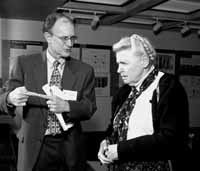 |
|
Millie Comes to Fermilab by Judy Jackson
It was a special pleasure, Millie Dresselhaus said, to visit the physics laboratory named in honor of her former teacher at the University of Chicago, Enrico Fermi.
"Young people are excited about high-energy physics," Dresselhaus said, "but there are serious career problems for youth. This is not just a Fermilab problem, but a problem for high-energy physics generally. It can be hard to envision a career when there is such a long lead time for experiments. The community will have to address this."
As a step in that direction, she began her laboratory visit with a "focus group" of Fermilab graduate students and young physicists, to hear what was on their minds and to assure them of her support.
The students responded enthusiastically.
Columbia University's Bonnie Fleming, a grad student at the MiniBooNE experiment, said she found Dresselhaus's experiences as a female physicist coming of age in the 1950's "inspiring."
Dresselhaus, a solid-state physicist known for her research on carbon-based systems, is on leave of absence from her day job as a physics professor at the Massachusetts Institute of Technology. She was sworn in as director of the Office of Science on August 7, 2000.
With an annual budget of $2.8 billion, Dresselhaus's new domain is among the largest funding agencies for basic research in the federal governmentówith by far the largest budget for research in the physical sciences, including high-energy physics.
And budgets were on everyone's mind during Dresselhaus's Fermilab tour, which coincided with enactment of key Congressional legislation that, among other things, will fund Fermilab's operations during FY2001. As news of the spending bill's provisions filtered in from Washington during the course of her visit, Dresselhaus voiced her thoughts on the outlook for battered high-energy physics funding.
"We all share concerns about the budget for high-energy physics in the United States," she said. "I believe that a budget of $800 million for high-energy physics is achievable [in FY2002]. The community has to have an open mind about how to get there. From what I see, if we work together it could be a very rosy picture. There should be no whining and moaning. We need to present the compelling nature of the science."
The Onsite Review gave Dresselhaus and Office of Science colleagues an opportunity to hear first-hand about the compelling science now getting underway at Fermilab. With CDF, one of Fermilab's two collider detectors, now comfortably ensconced in the Tevatron beamline and witnessing the first collisions of its engineering run, CDF spokesman Franco Bedeschi took a few hours off to talk about the exciting potential for discovery in Collider Run II at the Tevatron. Neutrino maven Janet Conrad, of Columbia University, gave Dresselhaus the "U.S. Nu's & World Report" on Fermilab's frontier neutrino experiments.
Dresselhaus, just back from a trip to CERN, the European Particle Physics Laboratory, said she is pleased by the March 1 start date for Run II at the Tevatron.
"It is clear that Fermilab understands that the laboratory must take advantage of the window of opportunity to make a contribution," she said. "Before the Large Hadron Collider at CERN begins operating, there is a critical gap, a critical chance to do physics. It is obvious that Fermilab sees that window clearly. We at DOE will do all that we can from our end to help Fermilab take advantage of it." Fermilab Director Michael Witherell described the challenges of operating a laboratory at the discovery frontier while at the same time developing its future in the context of inter- national high-energy physics research, in an era when funding for the field has been shrinking. Dresselhaus pledged to do her best to help. She told the Fermilab audience that she believes a realistic goal is to increase funding for the U.S. high-energy physics program by 15 percent next year.
"If we can do that for a few years, we'll have a good program," she said. "In fact, we have a good program in high-energy physics research. Now we have to sell it. That's my job." |
| last modified 10/20/2000 email Fermilab |
FRLsDFx9eyfrPXgV
 During her September 27-28 visit to Fermilab for an onsite DOE review of the laboratory, Dresselhaus, director of the Department of Energy's Office of Science, spoke with respect and affection of the professor she knew during her years as a University of Chicago graduate student, She referred often to Fermi's legendary concern for graduate students and young physicists. It's a concern she clearly shares.
During her September 27-28 visit to Fermilab for an onsite DOE review of the laboratory, Dresselhaus, director of the Department of Energy's Office of Science, spoke with respect and affection of the professor she knew during her years as a University of Chicago graduate student, She referred often to Fermi's legendary concern for graduate students and young physicists. It's a concern she clearly shares.
 "The meeting with Dr. Dresselhaus was like doing group therapy," said DZero graduate student Florencia Canelli next day. "I feel really happy to come in to work today."
"The meeting with Dr. Dresselhaus was like doing group therapy," said DZero graduate student Florencia Canelli next day. "I feel really happy to come in to work today."